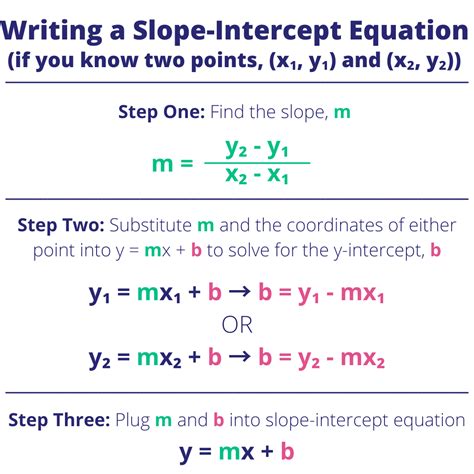Writing equations in slope-intercept form is an essential skill in algebra and mathematics. It provides a clear and concise way to express linear relationships between variables. In this article, we will explore five ways to write equations in slope-intercept form, along with examples and explanations to help you master this concept.
What is Slope-Intercept Form?

The slope-intercept form of a linear equation is written as y = mx + b, where m represents the slope of the line and b represents the y-intercept. The slope indicates the rate of change of the line, while the y-intercept is the point where the line crosses the y-axis.
Why is Slope-Intercept Form Important?
Writing equations in slope-intercept form is crucial in various mathematical and real-world applications. It allows you to:
- Easily identify the slope and y-intercept of a line
- Graph lines quickly and accurately
- Solve linear equations and inequalities
- Model real-world situations, such as cost-benefit analysis and physics problems
5 Ways to Write Equations in Slope-Intercept Form
1. Using the Slope-Intercept Formula
The most straightforward way to write an equation in slope-intercept form is to use the formula y = mx + b. Simply substitute the given slope (m) and y-intercept (b) into the equation.
Example: Find the equation of the line with a slope of 2 and a y-intercept of 3.
Solution: y = 2x + 3
2. Converting from Standard Form
Standard form is another way to write linear equations, which is ax + by = c. To convert from standard form to slope-intercept form, solve for y and rearrange the terms.
Example: Convert the equation 2x + 3y = 6 to slope-intercept form.
Solution: 3y = -2x + 6 → y = (-2/3)x + 2
3. Using the Point-Slope Formula
The point-slope formula is a useful tool for writing equations in slope-intercept form. Given a point (x1, y1) and a slope (m), the equation is y - y1 = m(x - x1).
Example: Find the equation of the line that passes through the point (2, 3) with a slope of 4.
Solution: y - 3 = 4(x - 2) → y = 4x - 5
4. Graphing Lines
Graphing lines is another way to write equations in slope-intercept form. By plotting the y-intercept and using the slope to find another point, you can determine the equation of the line.
Example: Graph the line with a y-intercept of 2 and a slope of 3. Find the equation of the line.
Solution: By plotting the y-intercept (0, 2) and using the slope to find another point (1, 5), the equation is y = 3x + 2
5. Solving Word Problems
Word problems often involve writing equations in slope-intercept form. By identifying the slope and y-intercept from the problem, you can write the equation.
Example: A company has a fixed cost of $500 and a variable cost of $20 per unit. Write an equation to represent the total cost.
Solution: Let x be the number of units and y be the total cost. The slope is 20 (variable cost per unit), and the y-intercept is 500 (fixed cost). The equation is y = 20x + 500
Conclusion
Writing equations in slope-intercept form is an essential skill in algebra and mathematics. By mastering the five ways to write equations in slope-intercept form, you will be able to tackle a wide range of mathematical and real-world problems with confidence. Whether you are solving linear equations, graphing lines, or modeling real-world situations, slope-intercept form is an invaluable tool in your mathematical toolkit.
We hope this article has helped you understand the concept of slope-intercept form and how to write equations in this format. If you have any questions or comments, please share them below.
What is the slope-intercept form of a linear equation?
+The slope-intercept form of a linear equation is written as y = mx + b, where m represents the slope of the line and b represents the y-intercept.
Why is slope-intercept form important?
+Slope-intercept form is important because it allows you to easily identify the slope and y-intercept of a line, graph lines quickly and accurately, solve linear equations and inequalities, and model real-world situations.
How do I write an equation in slope-intercept form?
+You can write an equation in slope-intercept form using the slope-intercept formula, converting from standard form, using the point-slope formula, graphing lines, or solving word problems.
